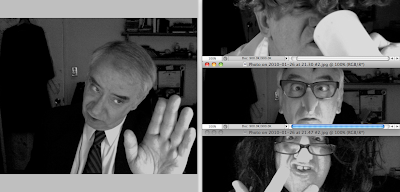
First the bad news: I tried to finish a post making fun of Chris Mathews' "Hardball" (sample frame above) in time to post it for Thursday morning, but it's not gonna happen. I bit off more than I could chew given the time I'm able to give this. Sorry about that.

Now the good news: have you seen the video introduction of the new ipad that debuted today? If not, go to apple.com and check it out. Be sure to watch the whole hour long video. Your first impression will be disappointment, because the machine Jobs describes at the start sounds like nothing more than a tablet-sized iphone...but stick with it. The Devil is in the details! You'll be cheering by the time the video's over.
Apple is revising their whole business model! Their idea is to give away the computer (I mean, sell it cheap) and make their money on the aps, which promise to be very appealing. The ap for Pages, which is Apple's version of word, is only 10 bucks, and it works faster and more intuitively than the regular version. Even if the ap version is scaled down, it's a bargain at 10 bucks. And the ibook ap...it'll put Kindle out of business.
It's also revolutionary in that it promises over time to make all consumer programs work by simple touch and drag and drop manipulation. I don't expect programs like Photoshop to convert overnight, but I wouldn't be surprised if a year or so from now an easy to learn, easy to use version of Photoshop Elements appeared. Apple has thrown down the gauntlet to the whole software industry: simplify or die! I loooove it! Steve Jobs is a genius!!!!!

Now the good news: have you seen the video introduction of the new ipad that debuted today? If not, go to apple.com and check it out. Be sure to watch the whole hour long video. Your first impression will be disappointment, because the machine Jobs describes at the start sounds like nothing more than a tablet-sized iphone...but stick with it. The Devil is in the details! You'll be cheering by the time the video's over.
Apple is revising their whole business model! Their idea is to give away the computer (I mean, sell it cheap) and make their money on the aps, which promise to be very appealing. The ap for Pages, which is Apple's version of word, is only 10 bucks, and it works faster and more intuitively than the regular version. Even if the ap version is scaled down, it's a bargain at 10 bucks. And the ibook ap...it'll put Kindle out of business.
It's also revolutionary in that it promises over time to make all consumer programs work by simple touch and drag and drop manipulation. I don't expect programs like Photoshop to convert overnight, but I wouldn't be surprised if a year or so from now an easy to learn, easy to use version of Photoshop Elements appeared. Apple has thrown down the gauntlet to the whole software industry: simplify or die! I loooove it! Steve Jobs is a genius!!!!!










































